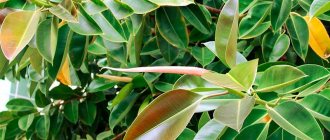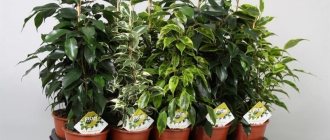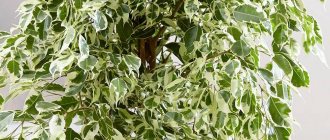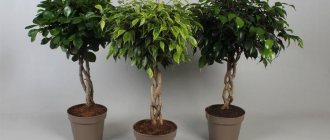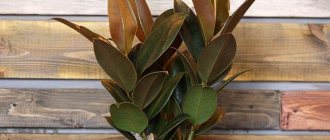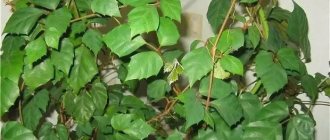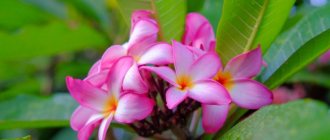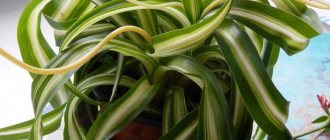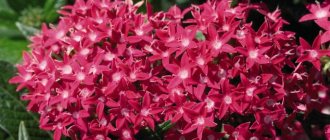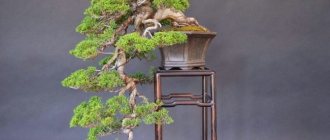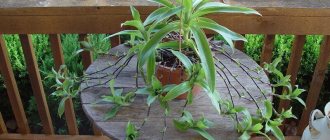» Flowers » Ficus Retuza - features of the variety
0
863
Article rating
Ficus Retuza, or Dull, is part of the Mulberry family. Known among home and office interior designers. It is often used as a basis for creating a bonsai tree. Unlike its wild evergreen relative, which reaches a height of up to 20 m, the indoor plant is small and compactly folded.
- Features of transplantation
- Rules of care
- Watering
- Top dressing
- Reproduction methods
- Cuttings
- Reproduction by air layering
- Crown trimming and shaping
- Prevention of diseases and pests
Ficus Retuza - features of the variety
Home care
Ficus Retuza is quite unpretentious in care , so even a novice amateur gardener can grow it.
However, in order for the ficus to grow large, you need to be patient, since this species grows very slowly.
Meanwhile, an adult plant will be an excellent and original decoration for any interior, delighting its owner with lush green leaves for many years.
Care after purchase
After you have brought the ficus home, you should as soon as possible find a suitable “place of residence” for it, where it will permanently reside.
The plant should not be placed where the air is too dry, near radiators or in the scorching sun. You should also not place it where there are drafts.
From the very first day, the ficus should be irrigated once or twice daily.
The next day, you need to check whether the soil is sufficiently moistened: if the soil is dry at a depth of ten centimeters, the plant should be watered.
Do not worry if in the first few days the leaves begin to fall from the ficus - in this way, it reacts to its new “home”, and very soon, with careful care, it will get used to it.
Watering
On summer days, ficus requires regular watering - the soil must be constantly kept moderately moist.
In winter, the plant should not be watered so much.
In general, the tree reacts normally to a short-term lack of moisture, but during active growth, drying out of the soil, as well as stagnation of water in the flowerpot, is unacceptable.
The crown should be sprayed regularly, making sure that as little water as possible gets on the trunk.
Crown formation
At first, the young plant grows chaotically, but from the second year the formation of the crown should begin and the trunk should be trimmed to the desired height.
If the shoots are weakly formed, the central shoot should be tied to a support.
Then it is necessary to constantly shorten the young shoots by one or two leaf primordia.
In winter, when the plant is dormant, branches that have become woody should be pruned.
Mainly in spring and summer, it is worth pruning new young leaves and shoots in order to properly regulate leaf growth.
The inner part of the crown is also subject to periodic thinning.
The upper branches are shortened - only three to four leaves are left, which promotes the development of the lower branches.
If the ficus leaves begin to turn yellow, they should be removed. A trunk that is intensively exposed to moisture may acquire a green tint at its base. It should be cleaned periodically with a soft brush.
The soil
For ficus Retuza, it is advisable to use ready-made soil for ficus or palm trees.
You can also prepare the soil yourself by mixing sand, humus and clay granules in equal quantities.
The plant is fed with a special fertilizer for bonsai or a universal fertilizer once two to four weeks in winter and every week from March to September.
Transfer
After three years, the plant is usually replanted for the first time. Young plants are usually replanted once a year, in early March, completely replacing the soil.
More mature plants are replanted once every two years, and the tiny roots, which are a tangled ball at the end of the rhizome, are carefully removed. Before replanting, a layer of drainage must be placed in the flowerpot.
Reproduction
Ficus propagation is carried out in the spring. This procedure is quite simple:
- it is necessary to select a ripe shoot and cut off its upper part;
- place the selected cuttings in a vessel with water;
- After the roots appear (usually after a couple of weeks), the shoot is planted in the ground.
Temperature
Ficus Retuza is quite comfortable at 15-25º C. It can stay in an apartment for a long time, and in the summer, when the temperature outside rises above fifteen degrees, the plant can be safely taken out into the open air.
The nuances of caring for various representatives of ficus
Lighting and temperature conditions. Ficus plants are not picky, but they love well-lit places that are not exposed to direct sunlight. The light should be diffused and bright.
If the ficus is placed in a shaded place, then its branches stretch out, and there are much fewer leaves on the trunk. It is advisable to place a flowerpot with a flower on a window (near the window), which faces east or west. Even in summer, leave ficus plants indoors, protecting them from drafts.
In summer, ficus will be comfortable at a temperature of 22-25 C, in winter it tolerates cool air well (not lower than 12-15 C).
Belonging to the same family, ficus trees have chosen different parts of the planet and, naturally, require different maintenance conditions. Some of them prefer to grow in partial shade, while others need more sunlight.
We have compiled an alphabetical list of ficus species, known and rare, with a description of their appearance and care nuances.
Ali is a variety of Binnendijk. In its native environment it is a tree up to 20 meters high. When kept indoors, its trunk does not exceed 50–60 cm. The crown, located in the upper part of the trunk, consists of sharp and elongated leaves, painted in light green tones.
READ MORE: Ficus tineke 28 photos, features of caring for ficus elastica and methods of its propagation at home
This species tolerates shade well, does not like drafts, and is demanding of additional nutrition. To create a beautiful appearance, it needs pruning.
Ficus macrophylla. Anastasia's leaves are dark green, with a light green border along their wavy edges. The central vein of the leaf plate is the same color.
Habitats: India, Northern Australia, Southeast Asia and the Philippines. It prefers a tropical climate, which means that at home it needs to be provided with good lighting and sufficient humidity.
Barok (Ficus Barok)
A characteristic feature of the species is the leaves curled across. Baroka lacks branching. To make it look beautiful in the interior, you need to plant several plants in a pot.
The dark green foliage leaves a pleasant impression. Flower growers are also well aware of the Baroque hybrid - Barok Variegata.
Bengal
Amazingly shaped view. The Bengal ficus has a trunk diameter that exceeds its height when grown indoors. Aerial roots hanging from the crown add exoticism to its appearance. The leaves have a dark green color and whitish veins.
Ficus Andrey, as it is also called, is easy to care for, but requires a large pot and regular pruning. It can grow in a well-lit place or in the shade.
Benjamin
One of the most popular types. In its genus there are both dwarf and tall varieties. It differs in the shape of the leaf blades, including ovoid, curly, and xiphoid.
Such beautiful varieties as variegated Birch, dwarf ficus Lovely and Reginald with dark blotches on the leaves are popular.
The Benjamin Mix barrel is painted in green and brown shades and is shaped like a cylinder. Needs abundant watering, bright lighting and spraying. Prefers a temperature of 18...23 °C.
Ficus Binnendijka
Binendijka, or willow-leaved ficus, got its second name because of the shape of the leaves, which are very similar to willow leaves.
Making up a lush openwork crown, they give the plant grace and airiness. The height varies from 2 to 3 meters, the crown diameter is 1.5–2 meters.
In its external characteristics it is very similar to species such as Samantha and Golden King. It has a compact size and grows slowly. The veins of the leaves are well defined.
Boucle is characterized by dark green leaves that curl inward, with the curl running along the central vein. Ficus is demanding on lighting; pruning is necessary to form the crown.
A representative of dwarf species, Ficus Viandi is loved by gardeners for its intricately curved trunk and small stature (only 30 cm). Its small leaves curve slightly along the central vein.
The decorativeness of the Golden King lies in the shape of its branches and crown. Bending in an arc, they intertwine with each other, giving the small tree a slender appearance.
The leaves look variegated due to the uneven yellow border along the edges. It requires good lighting and high humidity.
A beautiful indoor tree with dark green glossy leaves. It is impressive with its accelerated growth rate, it can grow by 50 cm in 1 year. It is undemanding to light and tolerates partial shade well.
Deltoid
The name of the species comes from the shape of its leaves, which resemble a letter of the Greek alphabet. The leaves are large, the color of bright green is diluted with small whitish inclusions on the upper side of the plate and black dots below.
Just like Cyatistipula (Ficus goblet stipule), this ficus prefers abundant watering and diffused light. Often used to create bonsai.
Karika
Most people know the ficus carica as a fig that bears delicious fruit. Kept at home, it can live up to 15 years. It should be noted that this species is deciduous, that is, every year it seasonally sheds its leaves.
The tree requires periodic pruning and replanting in order for it to develop well. The leaves are quite large; whitish veins are clearly visible on the green plates.
A small-leaved species with leaves that look like small hearts, the edges are corrugated. The stems spread along the ground, growing into it with adventitious roots. The branches can stretch up to 5 meters in length. Negatively perceives direct sunlight, likes high humidity. It looks good in the interior when it curls along a support.
The most famous and at one time very popular species. Ficus broadleaf with large dark green leaves, shining with gloss, has long been a home in our interiors.
If you don't pinch or trim it, it can grow beyond the ceiling. Regular replanting is important so that the plant’s root system is not crowded.
In addition to spraying, the leaves need to be cleaned of dust with a damp cloth.
Curly (Ficus Curly)
Curly attracts with its variegated leaves, in which white blots of different sizes are chaotically scattered across the dark green field.
In some places they look like a scattering of small spots, and on other shoots they can look like small puddles. Such an original plant needs a lot of light, humidity and heat.
Kinky (Ficus Kinky)
Kinki is a dwarf species with small, up to 4 centimeters, leaves with a glossy surface, light green in color. A cream border runs along the edge of the leaf.
At an early age it looks like a neat bush; as it gets older, it turns into a dwarf tree. To maintain decorativeness, it needs pruning.
Lyre-shaped
Ficus is named so because of the shape of its leaves, which resemble a musical instrument. In addition to their shape, the leaves are impressive for their size and rich dark green color.
In West Africa, where it comes from, the lyre-shaped ficus grows to a tall tree. When kept at home, the plant requires support and increased temperature conditions.
READ MORE: Rubber ficus: tips for planting and care. 115 photos of interior use and video of growing at home
The edges of the small dark green leaves are slightly ruffled. The trunk is straight. With proper pruning, a beautiful crown cap is formed at its top. It is undemanding in care and is a perennial.
In Monique's appearance, the drooping, thin shoots look like lush strands of hair. If the ficus does not have enough light, its shoots become very elongated and lose color.
The leaves are single-colored, green, with a beautiful wave running along the edges. In hybrid species, the leaves may be spotted. Golden Monique is popular among flower growers.
Montana mountain
A shrubby type of ficus with shoots in the form of vines, which are decorated with dark green foliage. The surface of the leaves is rough, the ends are pointed. After flowering it produces bright red fruits.
Undemanding to lighting, loves warmth, looks great in the interior.
Naomi (Ficus Naomi)
In terms of decoration, Naomi's leaves are interesting. They are colored in dark green tones, have pointed tips and wavy edges.
Requires good lighting and abundant watering. Among home ficus lovers, the Naomi Gold hybrid with golden-green foliage is popular.
A slow-growing type of ficus, attractive with glossy leaves that slightly curve inward. It is believed that Natasha brings happiness and love to family relationships.
Grows well in a warm and humid atmosphere. Does not tolerate sudden temperature changes. When gaining altitude, the trunk becomes exposed.
Nina (Ficus Nina)
One of the Benjamin varieties with sharp oblong leaves. Small leaf plates are painted in gray-green tones, decorated with a light yellow border along the edge.
The color of the leaves is similar to the Nina variety, but the stripe is lighter than the latter. The curved shape of the trunk is identical to Viandi. The leaves are small, up to 4 cm, slightly bent in the center.
Dulled
The ficus trunk is enclosed in gray-yellow bark. The leaves are thick, oval-shaped, with sharp tips. Like Ficus Sunny, this species loves diffused lighting. The crown requires shaping by pruning.
Pumila
A highly decorative species with numerous liana-like branches. The leaves are variegated, oval, with sharp ends.
It produces aerial roots, which enhances its decorative effect. High humidity parameters and abundant watering are important in care. Needs mineral feeding.
This species has an original leaf color. White drops are scattered on the green surface of the leaf as if chalk rain had left its mark on them. The trunk is gray-brown, the crown is thick and drooping.
Parcella is easy to care for and responds well to regular watering and high humidity.
Samantha is another variety of Benjamin. The grayish-green leaves are decorated with white, uneven stripes along the edges. Like all variegated species, it requires indirect light.
Safari has small leaves strewn with white and yellow spots, streaks, and dots. Bend inward along the central vein. Growth is slow.
Ficus Safari is capricious in care and has special requirements for lighting and watering.
Sacred
The sacred ficus is a huge tree up to 30 meters high. Grows in India, Nepal, Sri Lanka. The leaves of this tree grow up to 20 centimeters, they have a leathery surface and a dark green color.
Like Ficus Twilight, this species dies from excess moisture and temperature fluctuations. Pruning helps shape the crown.
Starlight has unusually variegated leaves, dotted with white and cream spots arranged in a random artistic pattern. The length of the leaf is 4–6 cm. There is a slight bend in the leaf blade.
Ficus prefers good lighting, but without direct sunlight. If there is not enough light, the leaves lose color and fall off.
Triangularis
What types of ficus are suitable for creating bonsai?
There are several of them - these are ficuses:
- Bengal (Ficus benghalensis),
- Benjamin (Ficus benjamina),
- carica or fig (Ficus carica),
- microcarpa (Ficus microcarpa),
- dark leaf (Ficus neriifolia),
- blunted / retusa (Ficus retusa),
- rusty red (Ficus rubiginosa),
- ginseng / ginseng (Ficus ginseng).
Let's look at photos of bonsai grown from each suitable type of ficus and determine exactly the type.
Photo of ficus bonsai.
| Bonsai grown from Bengal ficus. |
| Ficus benjamina bonsai. |
| Ficus carica bonsai. |
| Dark leaf ficus bonsai. |
| Ficus microcarpa bonsai. |
| Ficus retusa bonsai. |
| Rust red ficus bonsai. |
| Ficus ginseng bonsai |
Now that we have decided on the type of ficus , it is time to choose the form of bonsai that you are striving for, because it is impossible to create a bonsai without having a specific result in front of your eyes!
Botanical description of the plant
Ficus obtuse grows in the tropical zone of Asia and Australia. Under natural conditions it reaches enormous sizes - often the tree grows up to 15-20 m in height, has a huge crown and massive trunks. At home, it is grown only as a bonsai, and the height rarely exceeds 70-80 cm.
Description of Ficus retusa:
- smooth, massive stems with grayish-brown bark;
- the crown is dense, branched, with age the tree develops an aerial root system;
- the stems are flexible, can intertwine, bend towards the soil;
- leaves with thick skin, oval shape, have a pointed edge;
- the variegated variety is distinguished by the variegated color of its leaves;
- grows slowly - on average, in one year the height of the plant can increase by 5-7 cm.
In natural conditions, the pendant roots of a tree serve to support the branched crown. Descending to the ground, the air layerings gradually thicken, touching the ground, slowly take root and form new self-growing trees. When grown as a bonsai, the tree produces thinner, shorter aerial roots that can extend down to the soil or twine around the branches and trunk of the host tree. Thanks to their high flexibility, you can create original compositions by forming trunks in the form of braids or strands.
Antennaria or cat's paw Growing from seeds to seedlings Planting and care
Description
Ficus retusa came to us from tropical Asia; it also grows in Australia, but there it is called Lives-Pur.
This is a tree with a smooth thick trunk of gray-brown color. It has a branched dense crown and powerful aerial roots. The leaves of Retuza are leathery, oval, with a pointed edge.
There is a variegated variety of Blunt ficus. It has variegated leaves. Wood is very often used to decorate rooms; caring for it is somewhat more difficult than ordinary wood.
At home, ficus can be grown from seeds for bonsai. This is not difficult to do, but you will have to try.
It is not difficult to grow the Blunt Ficus at home: it is an unpretentious houseplant. Retuza takes root well and pleases the eye with its unusual appearance all year round.
When growing ficus, you need to know about the optimal conditions for its maintenance:
- sufficient lighting;
- air temperature at 20-25°C;
- moderate watering;
- regular feeding;
- neutral acid-base balance of the soil.
The plant does not tolerate drafts. This must be taken into account when choosing a place for him in the room.
Regular pruning of the tree is required to maintain the appearance and shape of the crown. The crown grows slowly and is pruned in the last days of winter or early spring. Special care is required for a living bonsai sculpture. It differs little from the usual one, but you need to pay more attention to trimming the crown.
In the warm season, it is best to take the ficus outdoors.
How to choose and how much it costs
The best time to buy is spring. During the spring-summer period, the indoor flower will have time to adapt and increase its vegetative mass before the dormant stage begins.
Preference for home cultivation should be given to young plants, as they are highly adaptable and quickly get used to new growth conditions.
When buying a Blunt ficus, you need to pay attention to its appearance. In a healthy person:
- bright, rich foliage color, without brown spotting;
- in variegated varieties, the leaf blade is unevenly colored, without the advantage of green;
- the root system is without damage and signs of rot and mold;
- the crown is quite thickened, with a uniform coating.
Average plant price:
- height up to 25 cm - 1500 rubles;
- up to 50 cm - 3000 rubles.
The acquired ficus is immediately placed in a permanent place of growth, because it does not like changes and when conditions change it begins to shed its leaves. A similar situation with leaf fall is observed after acquisition. This is explained by the adaptation of the flower crop to the new microclimate.
With properly organized care, a houseplant quickly restores the quality of the vegetative mass.
The flower is replanted 2-3 weeks after adaptation. The volume of the pot is selected such that there is up to 2 cm between the root system and the walls.
Golden ficus propagation methods
Ficus "Panda" (it is more correct to call it ficus obtuse variety "Panda" - Ficus retusa cv. Panda) is one of the most popular varieties of ficus obtuse. Its origin is easily recognized by the pointed-blunted shape of the leaves, which from a distance seem almost round at the top, perceived as oval. But this variety, which is so often called simply ficus “Panda” in catalogs and stores, has many individual characteristics and differences.
Ficus "Panda" is an evergreen woody plant, often growing in a multi-stemmed form or as a shrub. The shoots are strong, quickly become lignified, branch densely, and with age they themselves become deformed and thickened, which facilitates the formation of the plant and the creation of bonsai. The plant has very powerful and prominent aerial roots, thanks to which the plant looks elegant. “Panda” has greyish-beige, very light bark, on which light streaks are visible only on young branches.
The leathery leaves of this ficus are medium-sized and look very neat and unusual. Young leaves are golden in color and appear to glow, appearing at the end of February and throughout the entire active growing season. It is thanks to these golden leaves that “Panda” received the nickname “golden ficus”.
Unlike the base species and other varieties, the maximum length of the leaves is limited to 6 cm and the width to 4 cm. The color of the leaves is rich, medium to dark green with a muted underside. The foliage shines brightly, with a central, light and thin vein standing out on it. “Panda” does not have specks or dots along the edges of the leaf blades, but the color of the leaves themselves may differ in tone and saturation, which gives the crown an interesting light watercolor look.
One of the main advantages of the ficus “Panda” is the presence of original spherical green fruits, which, like beads, sparkle between the leaves and turn the crown into a strikingly elegant one. Flowering is almost invisible.
Ficus "Panda" is one of the best varieties for creating bonsai. Even without any formation, the plant is prone to gradual curvature and thickening of the trunk, creating strikingly beautiful lines. And small leaves, original fruits and the gold of young leaves make “Panda” stand out from the background of other varieties and ficus obtuse, and other species.
Cuttings that can be taken in spring and summer. After cutting, the cuttings of the ficus “Panda” are placed in water for several hours and then treated with a growth stimulator. Rooting should be carried out at a temperature of 25 degrees Celsius, with high air humidity, under a hood or plastic film and with bottom heating.
Air layering (in large bush plants). It is carried out according to the classical method, with an incision of the shoot along between two strong nodes and wrapping the cut with damp moss and substrate. After rooting, the shoot is separated from the mother bush.
Varieties
Based on the parent variety Ficus retusa, several varieties have been bred, incl. variegated. Some are grown at home.
- Thin-barrel. The maximum permissible height is 1.0 m. In appearance it looks like a compact shrub. The leaves are small in size, up to 6 cm long. The color is light green, with a light green tint on the inside. The trunk is large. A large number of aerial roots. The crown is dense.
- Albomarginata. The leaves are small, from 1 to 12 cm long. The color is dark and intense in the central part and noticeably lighter at the edges. Lignification and multiplicity of shoots are absent. Small crown.
- Hawaiian. The leaves are variegated, with a combination of light and dark fragments.
- Mutabilis. A variegated variety with yellow foliage and virtually no green pigment.
- American. Covered with leaves unevenly. The color is dark green, with gloss. In young ficuses, the middle of the leaf blades is light green.
- Green Silver Blue. The foliage is slightly elongated and narrow. The stems are thin.
Ficus benghalensis
Ficus benjamina photo So, the first stop is Ficus benjamina, which can be seen in the photo below: Of course, the description of this green beauty can take up a lot of space, but we will try to briefly reveal the essence of the plant. Ficus benjamina is one of the most common species for home growing. Its leaves are oblong, 6 to 12 cm long and 3 to 6 cm wide.
- Does not like frequent watering.
- Does not tolerate direct sunlight.
- Depending on the color of the foliage, it can be located in either a shaded or a bright place.
Ficus rubbery photo
This type of ficus is distinguished by massive leathery leaves of a dark green color or with light spots. Usually, in decorative conditions, the plant does not branch - the leaves are located on the trunk, which, with good care, can reach a length of up to 2 meters. And this is not strange, because the rubber ficus can add one leaf per week from the beginning of spring until late autumn.
- Prefers bright, but diffused light to direct sunlight.
- Loves moderate temperatures both in summer (20 - 25 ºC) and in winter (not lower than 15 ºC).
- Before each watering, the soil must dry out.
Ficus Bengal photo
Ficus Bengal is an evergreen tree that has the banyan life form in its natural habitat. Thus, having “settled” on a larger and stronger plant, the ficus releases aerial roots, which, having reached the ground, begin to take root and turn into a regular trunk. The leaves of this species are oval in shape, green in color with light green veins. In indoor conditions it can reach 3 meters in height, while in nature it can reach up to 40 m. Care:
- Light-loving plant (no direct sunlight).
- Likes moderate temperatures from 14 ºC in winter to 30 ºC in summer.
- Requires moderate watering, except during periods of active growth, when watering should be more frequent.
Ficus dwarf photo
This type of ficus is radically different from the above. Firstly, it is not a tree or a bush, but a herbaceous plant that can take root with the help of its own shoots. In a word, the shoots are thin, flexible, abundantly covered with foliage. The leaves can be round or oblong, depending on the variety. The color is also different: from light green, monotonous to variegated. Care:
- Can withstand a maximum temperature of 8 ºC in winter, and a maximum temperature of 25 ºC in summer.
- Loves a little sunlight in the morning or evening, for example, and diffused light.
- Watering is quite abundant - the soil should not be allowed to dry out completely.
Ficus montana photo
Ficus montana is a creeping shrub that is grown at home as a hanging plant. Its leaves are shaped like oak leaves, green in color, and slightly rough. The leaves reach 8 cm in length and 4–4.5 cm in width. The shoots are thin, brown-green in color. Care:
- The optimal temperature for this plant is from 17 ºC to 22 ºC.
- Loves partial shade or diffused light.
- Likes abundant watering in spring and summer, and moderate watering in autumn and winter.
Ficus creeping photo
A small shrub with climbing shoots. The leaves are small, round, rough, with wrinkles and a bright green pattern. There are some suckers on the lower part of the stem, due to which the plant can attach to any surface. Care:
- Loves moderate temperatures.
- Abundant watering will not harm the plant; it likes spraying.
ficus sacred photo
A representative of this species in its natural habitat has the life form of a banyan tree. And at home it is often grown as a bonsai. The sacred ficus is distinguished by a powerful trunk and gray shoots. The leaves are heart-shaped, green, and smooth to the touch. Care:
- Does not like direct sunlight, but bright, diffused light is favorable.
- Does not like sudden changes in temperature, the permissible minimum temperature is 12 ºC.
- Frequent spraying is necessary in all seasons.
Adaptation period and transplantation
The purchased ficus must be immediately placed in a suitable place for it. There should be no other plants nearby, as the flower will be in quarantine for 2-3 weeks. On the first day of being in the house, the tree is watered abundantly. The next day, check the condition of the soil. If, when you dig your finger 10 cm, you feel that the soil is dry, water it. Otherwise, repeat the procedure the next day. After the quarantine expires, transplant the ficus into a new pot.
Video: transplanting ficus obtuse
Transplantation and substrate
For the ficus of the blunted variety “Panda”, a standard soil mixture for any ficus is suitable. It is preferable to use a ready-made substrate. If you prepare the soil mixture yourself, mix equal parts of turf soil, leaf soil, peat and sand. The soil should be water- and breathable, loose, but not too light. Vermiculite or other loosening additives can be mixed into the soil. The optimal soil reaction is neutral.
It is better to replant this ficus as needed. For bonsai and adult plants, the top layer of soil is simply renewed annually by removing contaminated soil and adding fresh, clean substrate in early spring. A full transplant is postponed until the roots have mastered all the soil and begin to emerge from the drainage holes. Young ficus "Panda" trees migrate annually. The earth ball should not be destroyed; when replanting, the depth of the root collar is left the same. High drainage is laid at the bottom of the container (expanded clay and crushed brick are most suitable). Before growth resumes, plants are shaded and provided with a more humid environment.
Ficus "Panda" does well when grown hydroponically.
Required microclimate
Ficus does not tolerate drafts.
When growing Retuza at home, it is necessary to create conditions close to natural, tropical ones. The best place would be the south or west side of the room.
In the hot season, in bright sunshine, the indoor plant is shaded. Drafts, sudden changes in temperature and humidity, and shortened daylight hours are destructive.
Optimal humidity indicators:
- in summer - no higher than 25°C;
- in winter - no lower than 15°C.
Humidity
The required humidity is 50% or more. In the winter season, when heating devices are actively used, dry air is moistened by placing a container of water near a flower pot or by using professional humidifiers.
In addition to watering, foliage spraying is carried out in the summer. In winter, ficus is not sprayed.
Illumination
Retuza, especially variegated varieties, requires good lighting, through which variegation is ensured.
In winter, the required duration of daylight is 12 hours or more, and is maintained through the use of artificial sources - fluorescent lamps.
Ficus Pests
This ficus variety cannot boast of resistance to pests that spread in dry air. In the absence of measures to humidify the air, scale insects, spider mites, and mealybugs pose a danger. It is better to combat them by mechanically removing insects, correcting growing conditions, and in advanced conditions - by using insecticides.
Common growing problems:
- dropping leaves during sudden temperature changes;
- dropping leaves in cold drafts;
- partial shedding of leaves due to waterlogging;
- yellowing of leaves due to excessive watering;
- shrinking of leaves in dry air and with poor feeding;
- Drying or wrinkling of leaves in direct sunlight and low humidity
READ MORE: Do-it-yourself grinder, grinding machine, manufacturing drawings
Ficus obtuse, or Ficus retusa variety "Panda" (Ficus retusa cv. Panda)
It is quite difficult to detect any pest on variegated ficus trees - their traces are masked by the natural coloring of the leaves. Therefore, if the ficus has begun to shed its leaves, take a magnifying glass and carefully examine them on both sides.
Scale insects: look like brown plaques on the surface of leaves, petioles and stems, suck out cell sap. The leaves lose color, dry out and fall off.
Control measures. To mechanically clean pests, the leaves are wiped with a soapy sponge. Then spray the plant with Actellik solution (1-2 ml per liter of water) or water and spray with Aktar solution.
Spider mites: initially, small discolored spots appear on the leaves; if you look at the leaf opening, pinholes are visible. Gradually the leaves turn yellow and dry out. With severe damage, cobwebs are visible in the internodes and on the back of the leaves.
Control measures. You can use drugs such as Fitoverm, Actofit, Agravertin, Akarin - at the rate of 10 ml per 1 liter of water, or Vertimek (1 ml per 1 liter of water). The treatment must be repeated after 3-5 days - if the weather is hot or warm (26-24 degrees) and after 7 days if the air temperature is 20 degrees or lower, since these drugs do not kill tick eggs.
Thrips - the appearance is promoted by high temperature and low humidity. On the underside of the leaf, thrips lays numerous colonies, and light dots appear on the upper side of the leaf. As a result, the upper side of the leaf becomes grayish-brown with a silvery sheen.
Control measures. The plant should be sprayed, if necessary, repeatedly with insecticides (fitoverm, decis, actellik, inta-vir).
Read more about pests of indoor plants in the “pests” section
Features of cultivation
Like most ficuses, retusa varieties are unpretentious for home cultivation; they can easily tolerate short-term lack of watering or spraying, but they need to constantly maintain a high temperature and avoid drafts.
Planting technology and transplant timing
Retuza has not only a branched crown, but also a powerful root system with a large number of small shoots. This determines the diameter of the pot.
Choosing a pot and soil
For a pot, choose a wide and shallow container; the drainage holes in the bottom should be twice as large as those of other indoor flowers. It is optimal if there are small legs at the bottom to allow excess moisture to drain.
The purchased ficus can only be planted in soil consisting of sand, humus and granular granules in equal parts. The shoot is transferred from a permanent cup to a pot immediately and fed only after 2 weeks.
When transferring shoots to a new container, be sure to use a sufficiently thick drainage layer. At least 3 cm of the lower part should be occupied by broken brick, expanded clay and other drainage materials.
How to plant correctly
Before planting, the bottom of the selected container must be covered with mesh. Then a layer of drainage is poured, for which broken bricks, expanded clay, and small pebbles without sharp edges are suitable.
Then a layer of soil is poured, a cutting or an adult plant with trimmed roots is placed on it, if you are replanting. The soil is filled up to the root collar. The earth is poured to the top. There should be at least 2 cm left to the edges of the container. After planting, compact the soil with your hands.
When is it time to replant?
Transplants are performed depending on the age of the bonsai:
- the first time – 3 years after purchase;
- young trees are replanted with a complete replacement of the soil in March-April once a year;
- trees older than 2-3 years do not require a complete replacement of the soil; it is enough to remove damaged surface roots once every two years, remove the top layer of soil, replacing it with fresh substrate.
Subtleties of care
Care at home is not difficult even for novice gardeners, but certain rules must be followed. Ficuses prefer tropical growing conditions - constantly high humidity, temperatures within +25 degrees and above, the absence of sudden temperature fluctuations, direct sunlight and drafts.
Rules for watering and fertilizing
Watering should be constant, but not excessive. It is better to add small portions of water as the top 2-3 cm of soil dries out than to heavily flood the soil once a week.
Perform the procedure with settled water at a temperature of +30 degrees. It is necessary to prevent stagnation of moisture; to do this, immediately when planting, take care of the drainage holes and the presence of a drainage layer at the bottom of the pot.
Spraying is used for additional moisture. It is necessary to completely cover the leaves and trunk, as well as the roots protruding above the soil surface, with moisture. About once a month the plant can be bathed using a shower.
Pteris fern: description of species, home care
Feeding is applied during the period of intensive growth, which occurs in the summer. It is better to take complex fertilizers, in which phosphorus and potassium occupy the first place in concentration.
From mid-autumn, fertilizers with a low concentration of nitrogen are selected so that the plants can enter the dormant phase. In winter, ficus does not need nutritional components.
Diseases and possible problems
In general, ficus plants have high immunity, so most diseases occur only with improper care - irrational use of fertilizers, incorrect watering.
The following symptoms indicate the development of the disease or insect attacks:
- blackening or discoloration of leaves;
- softening and deformation of stems;
- signs of rotting on roots and foliage;
- leaf falling.
If the air in the room is too dry, the tree is attacked by spider mites. Its presence can be detected by the presence of a thin whitish web on the back of the leaves. Insects can be washed off with plain water and soap dissolved in it; it is also necessary to replace the top layer of soil.
When overwatered, root rot develops. It covers not only underground, but also aerial roots, eventually moving to the trunk and leaves. Rotting appears as black or dark brown spots on leaves and trunks.
Whiteflies, aphids, and mealybugs can spread to ficus from other indoor flowers. These insects are eliminated using modern complex insecticides, with which the plant is sprayed several times until the pests are completely eliminated.
Reproduction
Propagation from seeds is a labor-intensive method, so the cutting method or the vegetative option of transplanting shoots is more often used.
The procedure is performed in the spring so that the cuttings have time to take root by next winter:
- the top of the stem up to 15 cm long is cut obliquely, it must have at least two fresh leaves;
- the milky, caustic juice is washed off with warm water, then the cutting is placed in moistened sand;
- for the cutting you need to create a mini-greenhouse - put it in a warm place, cover it with a cut plastic bottle.
After at least 2 weeks, roots appear, after which the shoots can be replanted. Not only the top of an adult plant, but also a large leaf with part of the trunk (“heel”) can serve as cuttings.
To propagate by shoots, cut off the largest side shoot, remove the leaves, and make a cut at the bottom. Then apply a moistened piece of moss and wrap the bottom with film. It is necessary to moisten the cut area daily. As the roots grow, they should break through the film, after which the root can be transplanted into the ground.
When working, do not forget about protective clothing and gloves. Poisonous juice can cause skin irritation and even burns, and if it comes into contact with mucous membranes, it can lead to allergic reactions.
Ficus improves the microclimate of the room, absorbs harmful compounds, as well as electromagnetic radiation if located next to TVs and computers.
Problems during cultivation
Even a novice florist can grow Retuza. The plant adapts well to environmental conditions.
Problems with the plant appear when the rules of care and maintenance conditions are violated. The most common situations that arise are:
- Leaf fall. The causes of the problem are a decrease in air temperature, draft, excess soil moisture, change of location. Falling leaves can also be caused by excess fertilizer.
- The leaves fall gradually. The situation arises due to excessive watering and increased soil acidity.
- The edges of the leaves turn yellow. The cause of the problem is diseases of the root system. The roots may be susceptible to rot or pests. The situation occurs due to improper watering, irregular and insufficient feeding.
- Young leaves are small, and old ones turn yellow. The reason is dry air or poor feeding.
- The leaves wrinkle and dry out. The situation is provoked by direct sunlight. They cause burns.
The most common pests are spider mites, thrips, and scale insects. They infect Ficus obtuse, causing disease. You can get rid of pests using insecticides.
Reproduction methods
Ficus is propagated at home most often by cuttings and air layering. Much less often this is done with seeds.
Cuttings
Shoots with 2-3 leaves are suitable for cuttings. They are cut into pieces up to 15 cm long, washing off the remaining milky juice, and leaving to dry under natural conditions for 2 hours.
The cuttings are planted for rooting in a soil mixture of equal amounts of turf, leaf soil, peat, coarse river sand and humus.
If you intend to root the shoot faster, it is initially placed in water, changing it daily, and kept until roots appear.
Reproduction by air layering
Plants that are 2 years old or more can be propagated by layering.
Technology:
- a suitable area is selected on the stem and freed from foliage;
- make an incision 1/3 of the thickness, treat it with a root former and insert a foreign object (wood chips or polyethylene) to prevent the wound from healing;
- the cut is wrapped in sphagnum and covered with plastic film on top;
- As the roots grow, the air layering is cut off and planted in an individual pot for complete rooting.
Seed propagation
Gardeners do not prefer to propagate ficus seeds by seeds, because... This is a labor-intensive method. Suitable seed material is purchased in specialized stores, soaked before sowing in a solution based on a growth stimulant for 24 hours, planted to a depth of 1 cm, sprinkled with soil mixture on top and covered with plastic film.
For seed germination, it is necessary to maintain a temperature of about 25°C-27°C.
Containers with sown seeds are placed in a dark place. The first shoots appear after 2-3 months. After their germination, the seedlings are provided with good lighting and the film is removed. Seedlings are transplanted when leaves appear.
Crown trimming and shaping
Retuza is a suitable variety for bonsai-style formation. Trimming of the flower crop begins in the second year after planting, when it has fully adapted to the new place of growth.
Trimming technology:
- the trunk is cut to the required height;
- lateral shoots are shortened by 1-2 leaf primordia;
- thin out the crown inside;
- the lower tier of foliage is cut off;
- The direction of growth is set using a wire.
Woody branches are recommended to be pruned in early spring; young shoots can be shortened until autumn.
Description
The tropical regions of Australia and Asia are considered its homeland. It has the following features:
- flexible stems;
- dense foliage with durable skin;
- dense crown;
- smooth surface of the stems;
- the presence of a variegated variety with variegated expressive colors;
- slow growth and development: over the course of one year, the ficus adds no more than 7 cm to its height.
This type of ficus belongs to the mulberry family, but has differences in the shape of the trunk and foliage. The shape of the leaves is oval. The tips are pointed, the edges are slightly blunt. The branches are colored brown with a gray tint and covered with hard bark. The plant is characterized by the presence of a large number of shoots. In nature, the height of the tree can reach up to 20 m, it has a lush crown. Nevertheless, the plant is ideal for creating bonsai: the maximum growth when grown at home reaches 70 cm.
Under natural conditions for a tree, the crown is supported by hanging roots. The shoots descend to the ground and gradually become denser as they grow. Once they touch the ground, rooting begins. Over time, new trees appear on the ground, and the plantation gradually grows.
When ficus is grown in bonsai style, the plant produces small, thin aerial roots. As they develop, they begin to wrap around branches or droop. Florists use them to create original shapes. Ficus “Retuza” is also often used for decorating and stylizing rooms: thanks to the soft, pliable trunks, the tree can be given any shape.
Diseases and pests
Caring for a ficus is not difficult, but in order for the plant to be healthy and delight you with its juicy green leaves, you need to take into account a number of points:
- too much watering leads to rot on the roots and the appearance of dark spots on the leaves;
- watering in small quantities can weaken the plant and cause leaves to drop;
- shedding of leaves can also occur due to drafts and strong temperature fluctuations;
- Insufficient humidity can lead to leaf drop and spider mite infestation.
The main pests of the ficus Retuza are the white fly and various types of organisms that suck out the juice.
In order to prevent their appearance and reproduction, it is necessary to constantly monitor the leaves from the reverse side and eliminate pests that have not had time to develop.
But the most dangerous disease of this plant is anthracnose, which can be mistakenly confused with burns that appear on the leaves from direct sunlight.
Years later, ficus reappeared in our homes. Thanks to its unpretentiousness and ease of care, it has become a favorite of many gardeners.
Ficus Retuza is perhaps one of the most unusual species of this plant, capable of “revitalizing” any room and bringing to it an atmosphere of lightness and ease.
Ficus microcarpa
Ficus microcarpa plant is a miniature tree, which is also called bonsai. Bonsai is the art of growing miniature trees in apartment conditions, which are very similar in appearance to their larger relatives.
This ficus grows fruits, which is why it differs from other miniature trees. However, in indoor conditions this plant practically does not bloom, and therefore you are unlikely to see its fruits.
In nature, Ficus microcarpa is found in the tropical forests of China, Asia and Australia, but only in well-lit places. Growing this plant indoors is not so difficult, but if you do not take into account a number of important points, the plant will simply die.
The special beauty of this ficus lies in the flight of roots that rise above the soil, which can form various bizarre shapes. It also has a spectacular, very lush crown.
This species was called microcarpa because of its miniature fruits. So, from Greek mikros karpos is literally translated as a small fruit.
Description of ficus microcarpa
In nature it can grow up to 20–25 meters in height. When grown indoors, it rarely grows above 2-3 meters. As a rule, under natural conditions this plant is an epiphyte (grows on another tree).
The monochromatic, smooth, short-petioled leaves have a wide oval-lanceolate shape with curved tips. Upon examination, it may appear that the leaves are rubbed with wax.
Green or dark green foliage and brown bark. In nature it produces rather small fruits of a yellowish color, but as they ripen they become burgundy.
He does not like the scorching direct rays of the sun, and he is also negatively affected by low air humidity.
Caring for ficus microcarpa at home
This miniature ornamental tree, which prefers high humidity and reacts negatively to drafts and sudden changes in temperature, can be grown in an apartment if certain conditions are created.
Don’t be alarmed if, after purchasing or moving to another location, the plant loses all its leaves. This is his natural reaction. Thus, the ficus tries to acclimatize while maintaining as much strength as possible.
In a few weeks everything will be back to normal. At this time, it must be placed in a place with high humidity and the tree should be sprayed as often as possible. Under these conditions, new foliage will begin to grow after about a month.
Illumination
Moderate lighting is required, as well as mandatory shading from direct sunlight. Grows well in the back of the room in partial shade. It should not be frequently moved from one place to another. The fact is that the ficus can react to this by falling leaves. To at least partially avoid this, you can use the Epin biostimulator. The foliage is moistened with its solution.
Temperature
For this tree, the most important thing is not the temperature, but the absence of a sharp change in temperature (a difference of 5–7 degrees), as well as a draft. The most suitable temperature is from 16 to 23 degrees. At temperatures above 25 degrees, the soil can dry out quickly and the humidity in the room can significantly decrease.
In this case, the plant needs frequent and regular moistening of the foliage using a sprayer. Experienced flower growers advise purchasing an air humidifier. Settled water is poured into it, and the device must work for at least 10–12 hours, otherwise the plant will fly off its leaves.
Shedding of leaves can also occur if the room is constantly too cool.
Earth mixture
You can purchase a ready-made earthen mixture intended for palm trees (ficus) in a special store. You can also prepare it yourself at home. To do this, you should combine picking soil, sand and clay, taken in equal parts.
Air humidity
Ficus microcarpa needs high air humidity all year round. To increase humidity on hot days, you need to spray the leaves 1 or 2 times a day.
The same should be done during the winter period, when you cannot regulate the temperature in the room on your own. It is the leaves that need to be sprayed, not the trunk.
It is also recommended to wipe them with a soft cloth dampened in clean water.
How to water
Watering should be moderate. Overwatering leads to rot forming on the roots, which can result in the death of the plant. Water the tree only after the substrate has dried 2 or 3 centimeters deep.
Rain, melted water, as well as soft, lukewarm or room temperature water are suitable for this purpose. If the water is cold, this may cause the leaves to drop. The liquid that has flowed into the pan must be drained, since its stagnation in the soil can negatively affect the growth of the plant.
There is no specific watering schedule; in each case it is individual.
Features of transplantation
The plant is replanted infrequently, namely, once every 3 years. The fact is that this plant reacts negatively to transplantation, and if its root system is damaged, all the leaves may fly off. Another thing is that the trunk grows extremely slowly.
During transplantation, you can either completely or partially replace the substrate with a new one. You need to take a pot that is a couple of centimeters larger in diameter than the previous one.
At the bottom you must make a good drainage layer, which should consist of expanded clay mixed with charcoal. The soil needs to be loose, water-permeable and breathable.
Fertilizer
Needs regular fertilizers in spring and summer, once every 2 weeks. For this purpose, organic and mineral fertilizers are used for ficus (palm) trees. Or you can take a special fertilizer for bonsai. Fertilize before watering. Fertilizer can be dissolved in water for irrigation or for spraying plant foliage. In winter, fertilizers should not be added to the soil.
Pruning
To form a lush crown, the tree should be systematically pruned throughout the year. In young plants, the trunk must be pruned to increase its power and thickness.
Reproduction methods
Can be propagated by cuttings. To make a cutting, you need to cut off the top of the shoot and place it in water for rooting. At the same time, for pruning, it is necessary to select strong stems in which the fibers are fully developed.
The roots can be seen after 2 or 3 weeks. Then the plant is transplanted into the soil. It must be replanted annually until it reaches three or four years of age. Then this procedure is carried out once every 3 years.
Pests and diseases
A tree grown indoors is quite resistant to diseases and pests. However, if care is not taken care of, aphids, scale insects or mealybugs can settle on it. And as a result of this, the leaves become faded, begin to turn black, blackish spots may form on them, or they fly off completely.
Possible difficulties
- The foliage darkens and grayish spots form on them - stagnation of moisture in the soil, resulting in rotting of the root system. The cause may be water remaining in the pan.
- Curled, darkened leaves are a burn from direct rays of the sun.
- Frequent loss of all foliage - low humidity and poor watering.
Another reason could be: drafts, moving, frequent moving of plants to new places, sudden changes in temperature, watering with cold water, lack of light. - A spider mite settled on a tree due to the dry air in the room.
Harmful insects should be washed off with a moistened sponge, and it can be moistened in clean water or a soap solution into which alcohol should be poured (1 large spoon of alcohol per liter of water). We need to change the soil.
review
Loading…
Source: https://rastenievod.com/fikus-mikrokarpa.html
Benefits and harms
Due to its unusual shape, the ficus Retuza will become a decoration and highlight of any interior, not only in an apartment or house, but also in an office. In addition, it perfectly humidifies the air, saturates the room with oxygen and even has bactericidal properties.
If you are careful and make sure that the juice of this plant does not get on your skin (due to the possibility of causing allergic reactions), this plant does not cause any harm.
But for safety, it is better to place the ficus pot out of reach of small children.
